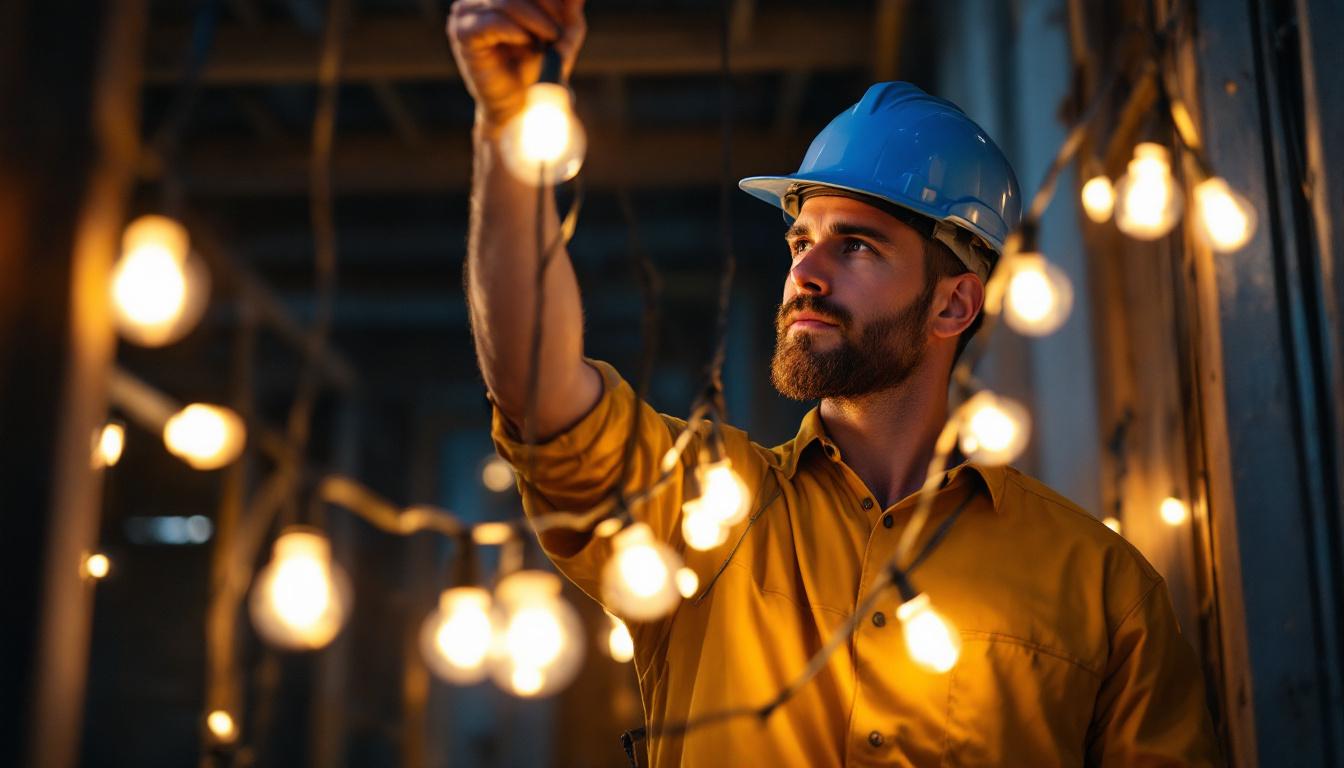
In the ever-evolving world of lighting technology, wafer lights have emerged as a popular choice among contractors and designers alike. These ultra-thin, low-profile fixtures are particularly appealing for their sleek design and versatility. However, like any lighting solution, they come with their own set of advantages and disadvantages. This article delves into the pros and cons of wafer lights, providing valuable insights for lighting contractors looking to make informed decisions.
Wafer lights, also known as recessed or slim LED downlights, are designed to be installed directly into ceilings with minimal space. Their low-profile design allows for a clean and modern aesthetic, making them suitable for various applications, from residential to commercial settings. These lights typically consist of a thin housing that contains the LED light source, making them ideal for areas where traditional fixtures may not fit.
One of the most compelling features of wafer lights is their design. The slim profile allows for seamless integration into ceilings, providing a minimalist look that many homeowners and businesses desire. This aesthetic appeal can enhance the overall ambiance of a space, making it feel more open and inviting.
Moreover, the availability of different color temperatures and dimming options allows contractors to customize the lighting experience to suit the specific needs of their clients. Whether it’s a warm glow for a cozy living room or bright white light for a workspace, wafer lights can adapt to various environments. The ability to adjust the lighting not only enhances functionality but also contributes to the mood and atmosphere of the space, making it more versatile for different occasions.
In addition to their aesthetic benefits, wafer lights can also be used creatively in design. For instance, they can be strategically placed to highlight architectural features or artwork, drawing attention to specific areas of a room. This versatility makes them a popular choice among interior designers looking to create visually stunning environments.
Energy efficiency is a significant consideration for lighting contractors and their clients. Wafer lights typically utilize LED technology, which is known for its low energy consumption compared to traditional incandescent or fluorescent bulbs. This efficiency not only reduces electricity bills but also contributes to a lower carbon footprint, aligning with the growing demand for sustainable building practices.
Additionally, many wafer lights have a longer lifespan than traditional lighting options, which means fewer replacements and less waste over time. This longevity can be a selling point for contractors aiming to provide value to their clients. The reduced maintenance costs associated with wafer lights can also be attractive to property managers and business owners, who often seek to minimize operational expenses.
Furthermore, the advancements in LED technology have led to improvements in brightness and color rendering, making wafer lights not only energy-efficient but also effective in illuminating spaces. This combination of efficiency and performance is essential for creating environments that are both functional and visually appealing, ensuring that spaces are well-lit while being mindful of energy consumption.
When evaluating wafer lights, several advantages stand out, making them an attractive option for lighting contractors.
Wafer lights are designed for quick and straightforward installation. Their slim profile allows them to fit into tight spaces, reducing the need for extensive ceiling modifications. This ease of installation can save contractors valuable time and labor costs, making wafer lights a practical choice for various projects.
Furthermore, many wafer lights come with integrated drivers, which simplifies the installation process even further. Contractors can often complete installations faster, allowing them to take on more projects and increase profitability. The lightweight nature of wafer lights also means that they can be handled easily, reducing the risk of injury during installation. This convenience is particularly beneficial in high-volume projects where speed and efficiency are paramount.
Wafer lights are incredibly versatile and can be used in a range of applications, from residential homes to commercial spaces. They are suitable for new construction as well as retrofitting existing fixtures. This adaptability makes them an excellent option for contractors working on diverse projects.
Whether illuminating a kitchen, hallway, or office, wafer lights can be strategically placed to achieve the desired lighting effect. Their slim design allows for creative installations, such as in soffits or under cabinets, providing contractors with numerous design possibilities. Additionally, wafer lights are available in various color temperatures and brightness levels, enabling contractors to tailor the lighting to meet specific client preferences and enhance the overall ambiance of a space.
In terms of initial investment, wafer lights can be cost-effective, especially when considering their energy efficiency and longevity. While the upfront cost may be slightly higher than traditional lighting options, the savings on energy bills and reduced maintenance costs can lead to significant long-term savings.
For contractors, offering wafer lights as part of a lighting solution can enhance their value proposition. Clients are often willing to invest in energy-efficient solutions that promise lower operating costs and a reduced environmental impact. Moreover, the durability of wafer lights means they typically have a longer lifespan compared to conventional bulbs, which translates to fewer replacements and less hassle for both contractors and clients. This long-term reliability can be a key selling point, as it aligns with the growing demand for sustainable and low-maintenance lighting solutions in today’s market.
Despite their many advantages, wafer lights also have some drawbacks that contractors should consider before making a final decision.
While wafer lights are generally effective for ambient lighting, they may not provide sufficient brightness for specific tasks or applications. In areas where focused lighting is necessary, such as workspaces or reading areas, contractors may need to supplement wafer lights with additional fixtures.
This limitation can be a concern for clients who require versatile lighting solutions. Contractors should assess the specific lighting needs of each project and recommend a combination of fixtures if necessary to achieve the desired brightness.
Another potential drawback of wafer lights is related to heat dissipation. Although LED technology produces less heat than traditional bulbs, wafer lights can still generate heat within their slim housing. If not installed correctly, this can lead to overheating, which may affect performance and longevity.
Contractors must ensure proper installation and consider the ceiling material and insulation when using wafer lights. Adequate ventilation is essential to prevent heat buildup, which could lead to premature failure of the fixtures.
While many wafer lights are compatible with dimming systems, not all models work seamlessly with every dimmer. This incompatibility can lead to flickering or buzzing, which can be frustrating for clients.
Contractors should be knowledgeable about the specific dimming options available for the wafer lights they choose. Recommending compatible dimmers can enhance the overall lighting experience and ensure client satisfaction.
When planning to install wafer lights, there are several key considerations that contractors should keep in mind to ensure a successful project.
The type of ceiling can significantly impact the installation of wafer lights. For instance, drywall ceilings are typically easier to work with than those made of concrete or other materials. Contractors should assess the ceiling structure and determine if any modifications are necessary for proper installation.
Additionally, understanding the insulation and ventilation requirements is crucial. Properly addressing these factors can prevent potential issues related to heat buildup and ensure the longevity of the fixtures.
Wafer lights require electrical connections, which means contractors must have a solid understanding of local electrical codes and regulations. Ensuring that all wiring is up to code is essential for safety and compliance.
Moreover, contractors should consider the load capacity of the circuit being used. Overloading a circuit can lead to tripped breakers or electrical fires, so careful planning is necessary to avoid these risks.
Educating clients about wafer lights is an essential part of the installation process. Many homeowners and business owners may not be familiar with the benefits and limitations of these fixtures. Effective communication can help manage expectations and ensure client satisfaction.
Contractors should take the time to explain the advantages of wafer lights, including their energy efficiency, aesthetic appeal, and versatility. Providing clients with information on how these fixtures can enhance their space can help justify the investment.
Additionally, discussing the long-term savings associated with wafer lights can further persuade clients to choose this option over traditional lighting solutions.
It’s equally important to address any concerns clients may have regarding wafer lights. Discussing potential limitations, such as brightness and heat dissipation, can help set realistic expectations. Contractors should be prepared to offer solutions or alternatives if clients express specific lighting needs.
By fostering open communication, contractors can build trust with their clients and ensure a positive experience throughout the project.
Wafer lights present a modern and efficient lighting solution that can greatly benefit lighting contractors and their clients. With their sleek design, energy efficiency, and versatility, these fixtures are well-suited for a variety of applications. However, it’s essential to weigh the pros and cons carefully, considering factors such as installation requirements, brightness limitations, and heat dissipation.
By understanding the unique characteristics of wafer lights and effectively communicating their benefits and limitations to clients, contractors can make informed decisions that enhance their projects. As the demand for innovative lighting solutions continues to grow, wafer lights are likely to remain a popular choice in the contractor’s toolkit.
Ready to elevate your lighting projects with the sleek design and energy efficiency of wafer lights? Look no further than LumenWholesale for the highest quality, spec-grade lighting products at unbeatable wholesale prices. Say goodbye to inflated markups and hello to superior lighting solutions that meet the highest industry standards. With LumenWholesale, bulk buying is a breeze, and with free shipping, you’re guaranteed premium lighting at the best value — no hidden fees, no compromises. Don’t miss out on the perfect blend of quality, affordability, and convenience. Wholesale Lighting at the Best Value is just a click away!

Discover the essential role of fluorescent lights in the world of lighting contractors.

Discover the essential guide for lighting contractors on selecting the best low voltage waterproof connectors.

Discover how work light strings are revolutionizing the lighting industry for contractors.

Discover the essentials of foot tube compliance for lighting contractors.